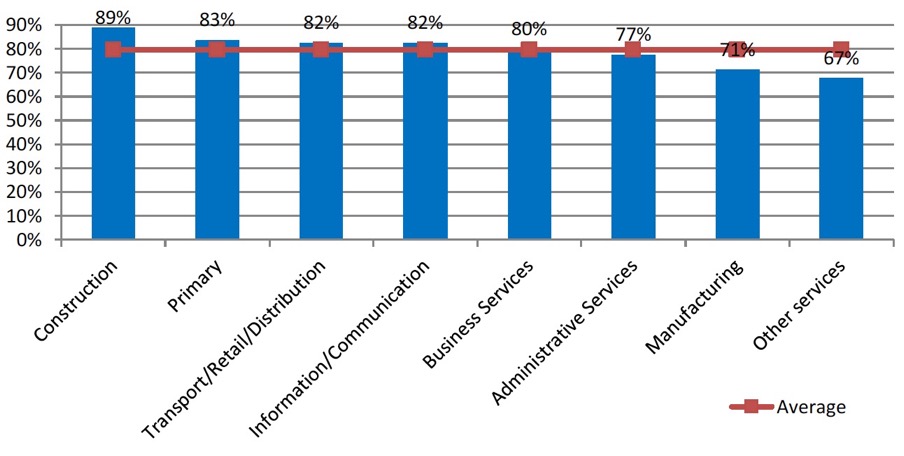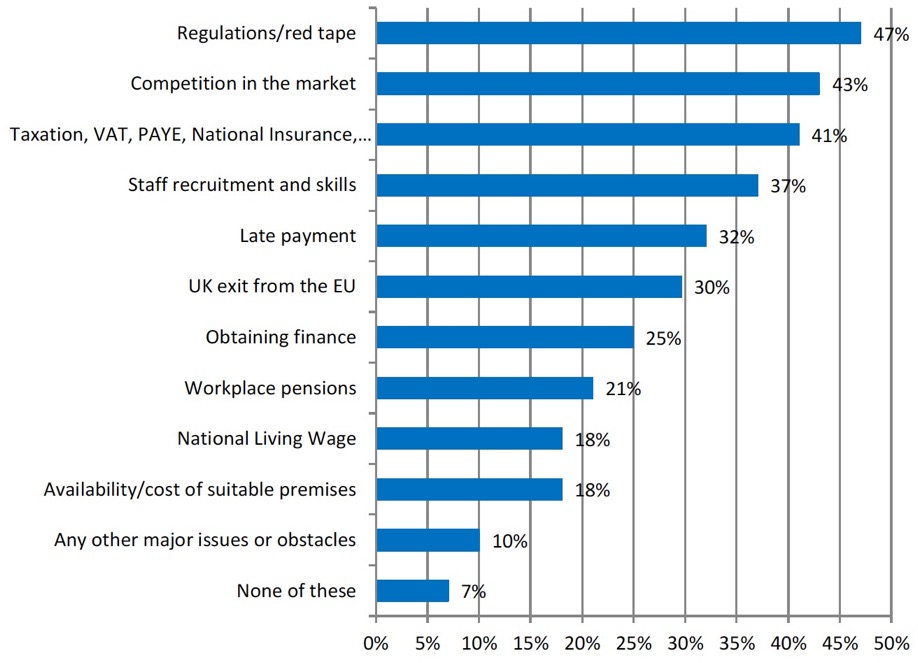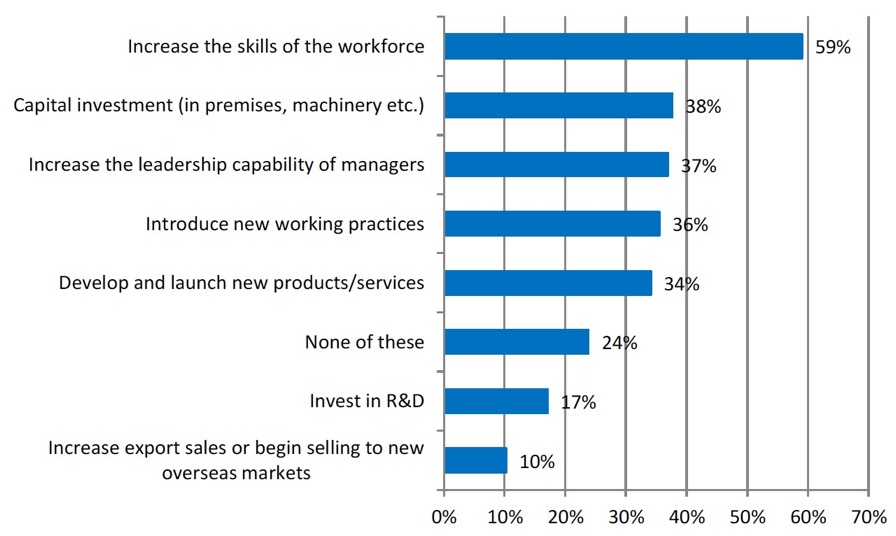Small Business Survey Scotland: 2017
Sets out the findings for Scotland of the Small Business Survey 2017.
This document is part of a collection
6. Business Performance and Outlook
The survey captures the opinions of SMEs on how they performed in the past 12 months and what they expect for the coming year, in terms of changes in employment size and turnover.
Changes to employment in the last 12 months
This section on changes to employment in the last 12 months is based on findings for panellists only (i.e. businesses that were interviewed in both 2016 and 2017) [23] .
33 per cent of SME panellists employed more people than a year previously. 37 per cent employed the same number and 30 per cent employed fewer. The proportion that employed more people than a year previously was significantly lower than in 2016 (48 per cent).
Table 6 below shows the net balance of employment growth by business size. The net balance is described as the overall proportion of businesses that increased employment, minus the proportion of businesses that decreased employment, compared to a year ago. Therefore, a positive figure indicates that more businesses within that category increased employment levels than decreased. In 2017, micro and medium businesses showed a positive net balance of employment growth, while small businesses showed a negative net balance [24] of employment growth.
| Table 6: Numbers employed compared to 12 months ago (%) by size Base: all SME employers panellists, 442 – Base minimum: Medium-sized businesses, 73 |
||||
|---|---|---|---|---|
| Has more employees now |
Same number |
Has fewer employees now |
Net balance - growth (% points) |
|
| Micro 1-9 |
33 |
41 |
26 |
7 |
| Small 10-49 |
31 |
24 |
45 |
-14 |
| Medium 50-249 |
46 |
13 |
42 |
4 |
| All |
33 |
37 |
30 |
4 |
Expectations of employment in the next 12 months
22 per cent of SMEs in Scotland expected to employ more people in 12 months’ time, broadly in line with the proportion in the UK as a whole (24 per cent) and with the proportion in the prior year (21 per cent). Eight per cent of SMEs in Scotland expected to employ less people, broadly in line with the UK as a whole (10 per cent) but lower that the proportion in the prior year (14 per cent). 70 per cent of SMEs in Scotland expected to employ about the same number, higher than the proportion in the UK as a whole (65 per cent) and in the prior year (65 per cent).
Medium-sized firms (38 per cent) were more likely than average to expect to employ more people in 12 months’ time.
Changes to turnover in the last 12 months
Of all SMEs that had been trading for at least one year, 33 per cent increased their turnover (value of sales) over the past year. 44 per cent had approximately the same turnover and 21 per cent had seen their turnover decrease over the past year. These proportions were broadly in line with those in the UK as a whole.
Table 7 below shows the net balance of turnover growth by business size [25] . SMEs of all sizes showed a positive net balance of turnover growth (i.e. higher proportions of firms experienced turnover growth than those that experienced turnover reduction).
Small and medium-sized businesses were more likely than average to have seen their turnover increase over the past year and less likely than average to have seen their turnover stay the same. The proportions seeing their turnover decrease over the past year were broadly similar across business sizeband.
| Table 7: Changes to turnover compared to 12 months previously (%) by size Base: all SME employers trading for at least one year, 736 – Base minimum: Medium-sized businesses, 133 SMEs that answered Don’t know/Refused: 7% |
||||
|---|---|---|---|---|
| Increased |
Decreased |
Stayed the same |
Net balance - growth (% points) [26] |
|
| Micro 1-9 |
31 |
22 |
46 |
10 |
| Small 10-49 |
41 |
19 |
36 |
22 |
| Medium 50-249 |
44 |
16 |
33 |
28 |
| All |
33 |
21 |
44 |
12 |
Expectations of turnover growth in the next 12 months
37 per cent of SMEs in Scotland expected turnover to increase in the next 12 months. 50 per cent expected turnover to stay approximately the same and 10 per cent expected turnover to decrease. These proportions were broadly in line with those in the UK as a whole.
Medium-sized SMEs were more likely than average to expect turnover to increase (57 per cent).
Profit
80 per cent of SMEs in Scotland generated a profit in their last financial year, broadly in-line with the UK as a whole (82 per cent). The proportion of SMEs generating a profit was broadly consistent across business sizeband.
Businesses in the Other Services sector were less likely than average to have made a profit (67 per cent). The results for all other sectors were broadly in line with the overall SME average (Figure 20).
Figure 20: Whether generated a profit or surplus in the last financial year by sector
Base: all SME employers, 739 – Base minimum: Information/Communication, 28
SMEs that answered Don’t know/Refused to this question: 3%

Major obstacles to the success of the business
Respondents were read a list of issues and asked which, if any, represented major obstacles to the success of their business. In line with the prior year, the two most commonly reported obstacles by SMEs in Scotland were regulations/red tape [27] (reported by 47 per cent of SMEs) and competition in the market (43 per cent). Other commonly reported obstacles included taxation/ VAT/ PAYE/National Insurance/business rates (41 per cent), staff recruitment and skills (37 per cent), late payment (32 per cent) and UK exit from the EU (30 per cent) (Figure 21). These issues were also the top six major obstacles noted by SMEs in the UK as a whole but with competition in the market coming out on top rather than regulations/red tape.
Figure 21: Major obstacles to the success of the business
Base: all SME employers, 739
Multiple answers allowed to this question.

The proportion of SMEs in Scotland reporting UK exit from the EU as a major obstacle increased by eight percentage points from the prior year (22 per cent). The proportion of SMEs in the UK as a whole reporting this as a major obstacle also increased significantly over the latest year (six percentage points) from 21 per cent to 27 per cent.
Those SMEs that reported UK exit from the EU as a major obstacle [28] were asked which obstacles they faced because of the UK’s forthcoming exit from the EU [29] . The most commonly reported obstacles were uncertainty about future regulatory changes (80 per cent), uncertainty about future access to EU markets (60 per cent) and increasing import costs (53 per cent). These were also the top three obstacles reported by SMEs in the UK as whole. Other obstacles noted by those SMEs in Scotland that cited UK exit from the EU as a major obstacle were decrease in investment (44 per cent), difficulty in recruiting skilled labour (31 per cent) and difficulty in recruiting unskilled labour (20 per cent).
Sales growth
60 per cent of SMEs stated that they aimed to grow sales over the next three years, broadly in line with the proportion in the UK as a whole. Small (81 per cent) and medium-sized businesses (86 per cent) were more likely than average to have growth ambitions.
By sector, SMEs in the Manufacturing sector were more likely than average to report that they aimed to grow future sales (77 per cent), while SMEs in the Construction sector were less likely than average to report that they aimed to grow sales (48 per cent).
Ways in which businesses plan to grow over the next three years
SMEs were asked whether they planned to do any of seven growth-related activities over the next three years. The most commonly reported activity was ‘increase the skills of the workforce’, cited by 59 per cent of SMEs. The least reported activity was ‘ increase export sales or begin selling to new overseas markets’, cited by 10 per cent of SMEs (Figure 22).
Figure 22: Whether plans to do any of these growth-related activities
Base: all SME employers, 739

Contact
There is a problem
Thanks for your feedback